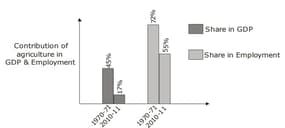In an imaginary economy, the monetary value of contributions of the private sector, public sector, primary sector, secondary sector, and tertiary sector is Rs., Rs., Rs., Rs. and Rs.. The Gross Domestic Product of the economy is:
Important Questions on Sectors of the Indian Economy
Which of the following reflects a situation where a person is employed but do not contribute in adding to the total product?
I. Open unemployment
II. Disguised unemployment
III. Seasonal unemployment
IV. Frictional unemployment
Shruti and Gautami were discussing India’s GDP and Kerala’s SDP. Some of the observations made were:
I. Kerala’s per capita SDP is India’s GDP divide by Kerala’s population in a particular year.
II. Since Kerala has best literacy rate and excellent quality of life indices, it must have the highest SDP.
III. In a federal structure if we know all the SDPs we can have a fair idea of how big India’s GDP will be in that year.
IV. Kerala’s per capita SDP in a particular year is the value of all final goods and services produced by the Kerala state in that year divided by Kerala’s population in that year.
The below graph shows the falling share of the agricultural sector towards both GDP and employment. Which one is the correct alternative?

Read the statements below carefully and choose the correct option.
: There exists considerable underemployment in agriculture in India.
: The erstwhile NITI Aayog is now known as Planning Commission.
: MGNREGA guarantees Days of employment in urban areas.
Read the statements given below carefully and choose the correct option.
: While counting goods and services produced in the economy, only intermediate goods and services should be counted.
: The relative importance of different sectors has shifted in favour of the secondary sector in India.
: The terms of employment in the organised sector are regular hence people employed in this sector can expect more job security.

